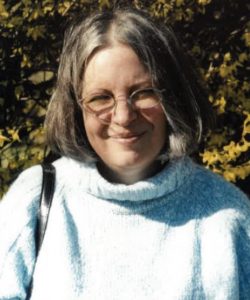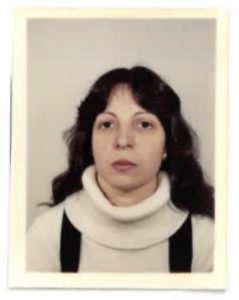
“When I have ‘Something to say’, I start being a composer; I work long and deep with the first spark, I inform myself, read, think, and let those musical feelings affect me and my techniques.”
In our archive there is a blue cardboard box, on which is carefully noted: “Musikhochschule Stuttgart should take care of the originals of my own compositions and documents (e.g. my own prof. title). 18.04.2004.” The composer Silvia Leonor Alvarez de la Fuente has collected her most important documents, compositions, and sketches here to preserve them for posterity. In addition to the blue box, there are numerous folders – just as neatly written – with letters, contracts and invoices. There are also further autographs and writings on music theory. Alvarez de la Fuente writes in one of her texts: “Music is experienced. Music needs no justification by philosophy, technical fashions, or clichés. It is one of the most independent, beautiful, and profound arts there is; that is why it is difficult and often pointless to talk about it.” Fortunately, she has nevertheless written a lot about music – her own compositions and those of others.
Silvia Leonor Alvarez de la Fuente was born on 18 March 1953 in Buenos Aires/Argentina. She studied music there and was appointed professor of composition in 1981. Nevertheless, she went to Germany in 1985 and once again studied composition. Why would a professor study more? Why does Alvarez de la Fuente go to Germany at all? In her estate, the only possible answer is a scholarship from the Konrad Adenauer Foundation, which enabled her to study in Germany.
Argentina under military dictatorship
After the end of the war, Argentina was marked with political and economic instability until the 1980s. Time and again, military coups put an end to democratic processes. Alvarez de la Fuentes’ childhood was during the dictatorship of Jorge Rafael Videlas, under whose leadership some 30,000 people disappeared – among them, many students whose mothers demonstrated in the Plaza de Mayo despite the danger to their lives, and thus went down in history as Madres de Plaza de Mayo (Mothers of the Plaza de Mayo). In 1983, the country returned to democracy. But could Alvarez de la Fuente have known this in 1985 when the opportunity arose to go to Germany? Did she go for political reasons? Or was the economic situation so unstable that she had more hopes of becoming an artist in Germany? We don’t know; there are no documents on these questions in the estate.

Was it music that drew Alvarez de la Fuente to Europe? From an early age, she was interested in Anton Webern’s compositions, but also in the fugues of Johann Sebastian Bach. She was likewise interested in the compositional techniques of so-called New Music, so it was only natural to come to Germany. Once there, Milko Kelemen accepted her into his composition class at the Stuttgart Musikhochschule, where Adriana Hölszky and Mia Schmidt, among others, studied – although not at the same time as Alvarez de la Fuente.
In her own composing, it was important to her that she “have something to say”. How she “says it”, the aspect of technique, came second for her. “I basically write in traditional notation as much as possible. My scores don’t look particularly exciting. I think that what is important is what you hear, not what you see.” Compared to the scores of other composers of the time – including Leni Alexander – Alvarez de la Fuente’s notations are indeed traditional. What is fascinating here is the care she takes with the scores, the annotations, and the thoughts she often adds to the autographs. The starting point for her compositions were often texts and poems by South American poets such as Gabriela Mistral or Jorge Luis Borges. They did not always serve as the basis for vocal compositions; sometimes they inspired Alvarez to write purely instrumental compositions.
Networking in southern Germany
Even during her studies, Alvarez de la Fuente was well connected in the (South) German music scene. Her music was premiered by numerous ensembles and broadcast by Süddeutscher Rundfunk, including her choral piece Tiempo y Sueño. It is particularly interesting to note that she joined the Internationaler Arbeitskreis Frau und Musik e. V., the supporting association of the Archiv Frau und Musik, shortly after moving to Germany. However, only two years later she resigned again. In a letter to the then chairperson of the association, Siegrid Ernst, she describes her reasons: Even though she was of the opinion “that women generally have it harder than men in the workplace”, the political situation in Argentina as well as her health and material problems burdened her so much that she was not able to actively support the goals of the working group. Alvarez de la Fuente’s estate does not contain any other concrete statements on women’s issues. But she was in contact with Roswitha Sperber, who had founded the festival Komponistinnen gestern-heute (Women Composers Yesterday-Today) in Heidelberg, and dedicated herself to promoting the music of women composers. In 1992, the festival’s ensemble commissioned Alvarez de la Fuente to compose a piece. The result was Piececitos for voice, flute, piano, percussion, and tape, based on texts by Gabriela Mistral. Sheet music and a recording of the premiere can be found in our estate.

In 1989, Alvarez de la Fuente completed her composition studies in Stuttgart, after which she worked at various music schools. At the same time, she continued to compose. The last years of her life saw Alvarez de la Fuente’s collaboration with Dietburg Spohr and her ensemble <belcanto> – Dietburg Spohr Frankfurt. However, the years were marked above all by the health ailments, which Alvarez de la Fuente hinted at as early as 1986 in a letter to Siegrid Ernst: she was probably suffering from delusions and paranoia – there is no psychological diagnosis. Little by little, Alvarez de la Fuente broke off all contact with her family and acquaintances, and hardly ever composed any more as her files filled up with medical correspondence. After her self-imposed passing in 2004, Alvarez de la Fuente’s estate went to Dietburg Spohr as she had requested, who then – also at the composer’s request – entrusted it to the Archiv Frau und Musik. There are numerous notes and audio recordings within to inspire other artists and to carry the music further: “I cannot and do not want to commit myself to a single, striking, and definitive opinion about new music. I want to constantly change and evolve. The opposite is the death of music.”
After Once the rights have been cleared, numerous audio recordings, photographs, and autographs from the estate of Silvia Leonor Alvarez de la Fuente will be available for viewing on the Digital German Women’s Archive website.
As part of the project #WhatAreWeWaitingFor?, a personal essay on Silvia Leonor Alvarez de la Fuentes has been published in the Digital German Women’s Archive.
Further reading (German):
- Spohr, Dietburg: …verloren…Stationen eines Lebens. Silvia Leonor Alvarez de la Fuente, in: Archiv Frau und Musik (Hg.): VivaVoce Nr. 71, 2005.
- Koch, Gerhard R.: Zum Tode der argentinischen Komponistin Silvia Alvarez de la Fuente, in: Archiv Frau und Musik (Hg.): VivaVoce Nr. 68, Sommer 2004.
- Lienhard, Daniel: Silvia Alvarez de la Fuente: Ein Leben auf zwei Kontinenten, in: clingKlong, Nr. 52, 2004.
